We’ve all been there: palms sweaty and heart racing just before we are supposed to take the exam that we feel completely unprepared for. To make matters worse, we are surrounded by classmates who seem to know exactly what they’re doing while we flounder in our own panic!
 Photo by Thought Catalog on Unsplash
Photo by Thought Catalog on Unsplash
Okay, perhaps we are a bit removed from these experiences at this point in our lives, but our students certainly aren’t! In fact, as we are all aware, they often experience similar anxiety every time they’re asked to read and write in the classroom, surrounded by classmates who just seem to “get it.” Therefore, I provide you with a reading and spelling rule that will continue our mission to reduce the stress in our students, bringing them closer to acing that exam.
Before You Begin
Getting Started
At this point, you’re probably asking yourself why we started off with such a stressful topic. Aside from putting us into the shoes of our students, the word ‘exam’ has a very difficult spelling pattern that is often overlooked. You see, the letters E-X, when combined, sound like the name of the letter X on its own, which throws off many students. Furthermore, the corresponding phoneme for “X” is a complex sound that sounds like something akin to the combination of /k/ and /s/.
As educators, we often see students who struggle with spelling words that begin with EX. Take a moment to think about how you’ve seen your students spell any of the following words:
Example, Explain, Extent, Exact, Exist
I’m sure you’ve seen many different spelling combinations including:
Xample, Ecsplain, Exstent, Egzact, Agzist
Of course, we know that these versions of the words are not quite right, but to our students, this sound is pretty difficult. That’s why we’ve created a spelling rule to give students an EX-plicit formula for this spelling sound.
Extra Exam
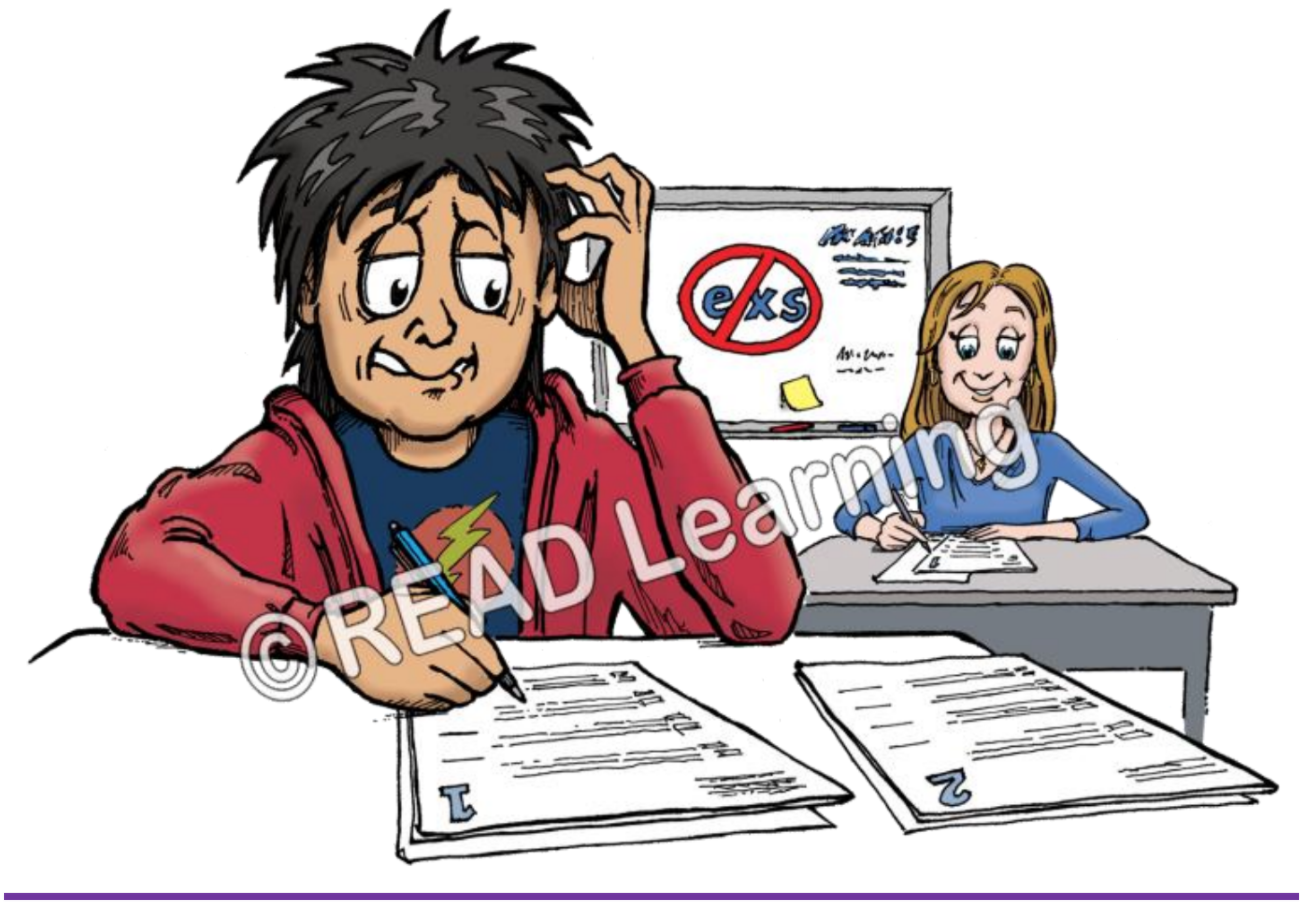
Our spelling rule, Extra Exam, shows students how to read and spell words that have EX as their beginning syllable. Let’s revisit that list of words from above and sort them into two categories:

You may notice that there are two sounds that EX can produce: one that sounds like /egz/ and another that sounds like /exs/. The sound that EX will produce, depends on the sound that follows it. If there is a consonant sound after the EX, it will sound like /exs/, but if there is a vowel sound after the EX, it will sound like /egz/. When teaching this to your student, consider exploring this concept in a similar way using syllable division and a guided sort of various words spelled with EX. Point out that, although it sounds like there is a Z or an S in each word, those sounds are simply part of that tricky letter X, and they often carry into the second syllable of the word.
At Silver Moon, we know that spelling and reading rules (also called spelling and reading patterns) are easier to remember if we have a catchy phrase or visual to go with them, so we’ve given you both! Here’s the complete rule for EX called “Extra Exam”:
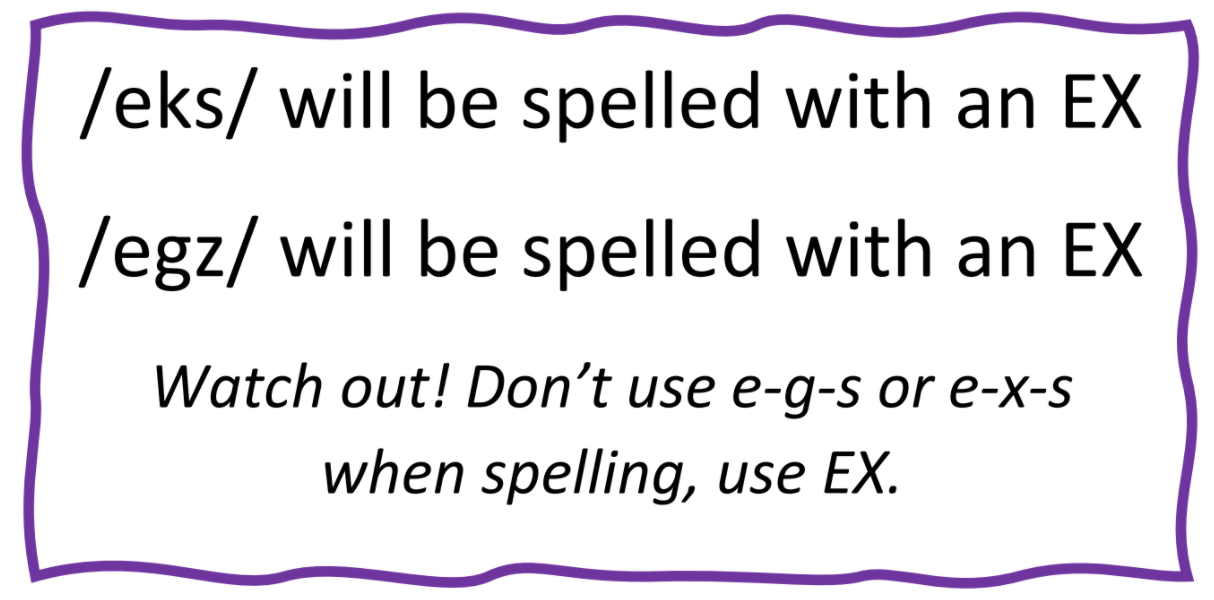
After presenting this rule to your student, be sure to practice both words that sound like /exs/ and those that sound like /egz/. Following this guided practice, you can easily make a connection between spelling words with EX and reading words with EX.
Important Tips to Consider
Before We Turn in that Exam
Hey, sometimes the exam is only as hard as we make it in our minds. It turns out, this one was pretty simple, and better yet, we’ve aced it! As you take one last deep breath to release all of that test-taking anxiety, click on the link below to download your FREE reproducibles to help your students practice the Extra Exam rule. I promise they might even be more fun than they are stressful.
As always, if you found this blog helpful, please share it with your fellow teachers, parents, and interventionists. Interested in learning more? You can find more spelling topics HERE, and don’t forget to check out our complete set of teaching resources at www.Silvermoonspellingrules.com.
Happy Teaching!
Written by:
Kate Wagner, BSE
Reading Interventionist, Remote Learning Coach
As a natural English language inquirer, my friends have come to see me as the resident spelling guru of our group, so naturally, I get all the puzzling spelling questions. My most recent inquiry was, “I heard that something called schwa is the most common vowel in the English language. I thought the only vowels were ‘a, e, i, o, and u.’ What in the world is a schwa?” At this point, I asked her if she really wanted to know. I mean, I get pretty jazzed about these sorts of topics, but I wasn’t sure if she was ready for a full-blown English lesson. This schwa thing is sort of a crazy concept that takes some sorting out. Since you’re here, I’m guessing you have a bit more patience than my friend did, so today, I’ll take you through the schwa journey. Before we can begin this journey, let’s talk about prerequisite skills to teaching schwa.
Before You Begin
Getting Started: What is Schwa?
Now, in order to get you into the correct frame of mind for schwa, picture the audible sound you might make as you leave the hustle and bustle of the workplace to sit down in front of a crackling campfire or, perhaps, the beautiful scene of a glassy lake. You’re probably making that sweet sound of relaxation. “Uhhhh...” I’ll give you a visual to aid in the imagery.
 Photo by James Wheeler on Unsplash
Photo by James Wheeler on Unsplash
“Uhhhhh...” That’s exactly the sound we’re going to talk about today. You see, there’s this tricky thing that happens to the sounds of some vowels when the conditions are just right. It’s kind of like finding that perfect fishin’ hole just before it rains. It doesn’t happen all the time, but when it does, things get interesting! That situation is called a schwa. What’s a schwa? Well, it’s a special sound that certain vowels make in the right conditions. That sound is the same sound that the short letter “u” makes!
So, back to my friend’s question, “Why is schwa the most common sound in our language?” Well, the letters that can change to that schwa sound in the right conditions happen to be a, o, e, and i. And of course, ‘u’ already makes that same sound as schwa. Therefore, schwa shows up a A LOT in our language. In fact, we probably end up saying “uhhh” more than we realize! Now we know that schwa and its corresponding sound is incredibly common, but I haven’t exactly explained why it exists. Schwa happens when saying the regular vowel sound would be too much work for us to say efficiently. You see, despite its lazy sound, schwa exists so that we can speak more quickly and efficiently. Let me give you an example:
..........Say the word, “America.”
..........Now, say it again, but say each ‘a’ with the long /A/ sound instead of the schwa sound.
You might have noticed that the second way was much more difficult to say. That’s exactly why we created schwa. If we go back to the word “America,” there are two letters that changed to that schwa sound. I’m going to mark them with the schwa symbol. It looks like an upside down ‘e’ in most dictionaries.
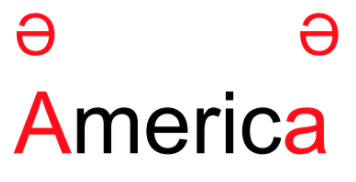
As the most common vowel sound in the English language, schwa can appear in many different situations. We have a rule for each of these situations, but today, I’m just going to talk about one of those schwa rules. In the word above, each of the letters that changed to the schwa sound is the letter ‘a.’ That’s the first part of the rule. The second part of the rule is that they are both open syllables. This means that when the word is split into syllables, these letters are open at the end of each syllable. The final part of the rule states that they are unaccented. This means that the schwa (any schwa) cannot appear within a syllable that is accented. Every word in our language has exactly one accented syllable, and because schwa is such a lazy sound, it would rather be in an unaccented syllable. Notice that this rule will have three components to it: letter ‘a,’ open syllable, and unaccented syllable.
Note: Accented syllables will ALWAYS follow the regular spelling sounds, and they will sound exactly as they look. Accented syllables are rule followers!
Majestic America
Before I give you the complete rule, I want you to try something for me...
..........Say “Majestic America”
..........Now, divide each word into syllables. It should look something like this:
..........Ma·jes·tic A·mer·i·ca
..........Listen as you say it. Do you hear those schwa sounds? Mark the letters that make that schwa sound /uh/.
![]()
To keep things simple, the name of our rule also has clues as to how the rule works! Majestic America is no exception. In fact, our open-‘a’-schwa rule can be found three times in the name of this rule! Here’s our complete spelling rule:
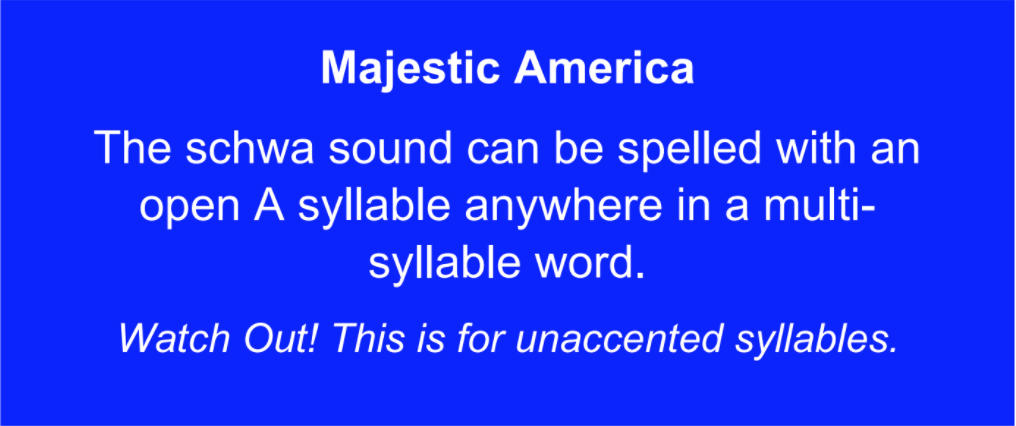
Do you remember that beautiful scene we explored at the beginning of our discussion? You’ll find a similar visual on our spelling rule card as well. It serves as a reminder of the name of our rule and the overall “vibe” of schwa: a lazy and relaxed /uhhh/ sound.

To get students used to this concept, I might walk through a series of visual and auditory drills to reinforce the sound for schwa, as well as how to spot it in a word. I will give you guides for both drills in our FREE reproducibles at the end of this blog. Don’t forget that there are many more quick and easy activities in our Silver Moon Spelling Kit!
Important Tips to Consider
Before We Relax
This brings us to the end of our UH-mazing journey across America. As you settle into your comfy chairs, you can rest easy knowing that you have some great resources coming your way as you navigate schwa with your students. Click on the link below to download your reproducibles and get started!
Majestic America Reproducibles Here
As always, if you found this blog helpful, please share it with your fellow teachers, parents, and interventionists. Interested in learning more? You can find our other spelling topics HERE, and don’t forget to check out our complete guide to spelling at www.Silvermoonspellingrules.com. If you need help understanding syllable division rules see our video section (vlogs) HERE.
Happy Teaching!
Written by:
Kate Wagner, BSE
Reading Interventionist, Remote Learning Coach
As the days get longer and the weather gets warmer, it’s easy to allow our minds to wander to lazy summer days eating sweet treats to the tune of carnival rides and laughter. I’d like to keep this sentiment alive with our next rule: Taffy Apple.
 Photo by John Jackson on Unsplash
Photo by John Jackson on Unsplash
When it comes to sweets, it’s really difficult to have just one, so let’s have TWO. After all, this is a doubling rule!
Before we dig into this sweet, sticky rule, let’s go over some prerequisite skills your student should have before they begin to double letters in the middle of words.
Before You Begin
Getting Started
What I find challenging about doubling rules is that, although there may be two letters in a row, we can only hear one sound. One letter is voiced, while the other is silent. Therefore, it’s easy to miss a doubling rule.
Start by getting your student acclimated to doubled letters, syllable division, and syllable types. You can do this by giving your student the following list on a piece of paper with the attached guided practice instructions. I have another version of this list in my FREE reproducibles download at the end of this post with an answer key.
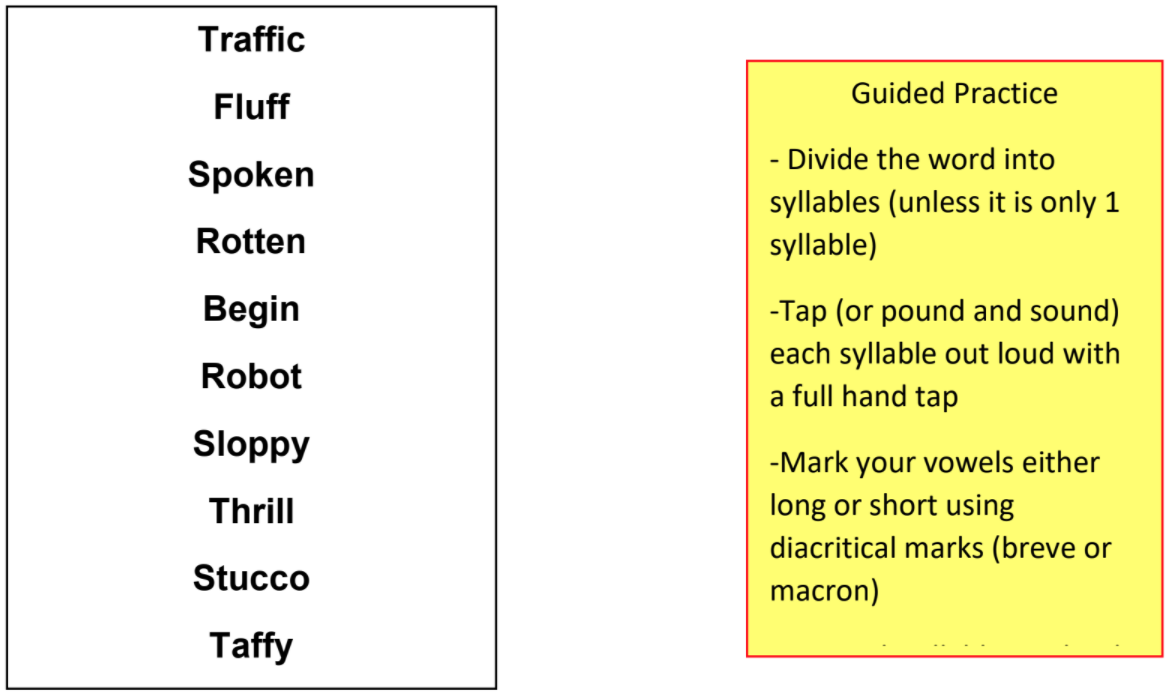
Biting into Doubling
Now that you’ve primed your student for this rule, pull just those words from the list that have doubled letters.
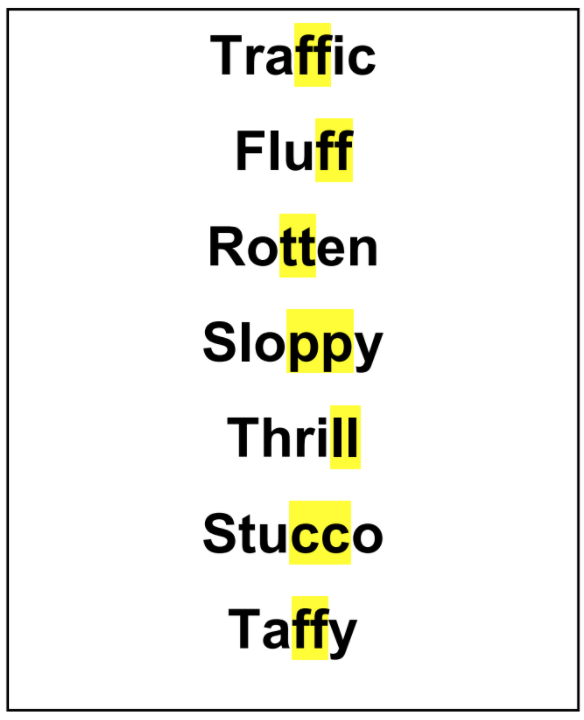
Notice that we already know why two of these words have doubled letters. “Fluff” and “Thrill” both follow an old familiar rule, Sam Loves Fried Zucchini. Of course, Sam Loves Fried Zucchini is only for 1 syllable words. The other words will follow our new doubling rule because our new doubling rule is for the middle of multi-syllable words. As your student taps out the remaining words, make note that there are short vowel sounds at the end of the first syllable in each word, so what you’ll hear is this:
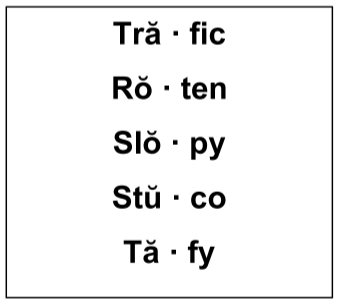
What’s important to connect is that short vowels must be closed by a consonant, so spelling these words as I have them above is a bit of a conundrum. Let’s look at the word “Tafy” for example. The ă as it’s written here would be read long (ā) because it’s not closed. Do not fear! We are not without hope for closing these short vowels. All we need to do is double the next sound after the short vowel.
Taffy Apple
As you might have noticed, this is a tricky rule to explain without first taking your student on the same journey that we just took together. And where are we now? Well, we’re at the moment we’ve all been waiting for: the moment we sink our teeth into our new spelling rule. When I think of the name of this rule, I can imagine the sweet, delicious crunch of a taffy apple, and I hope you can too!
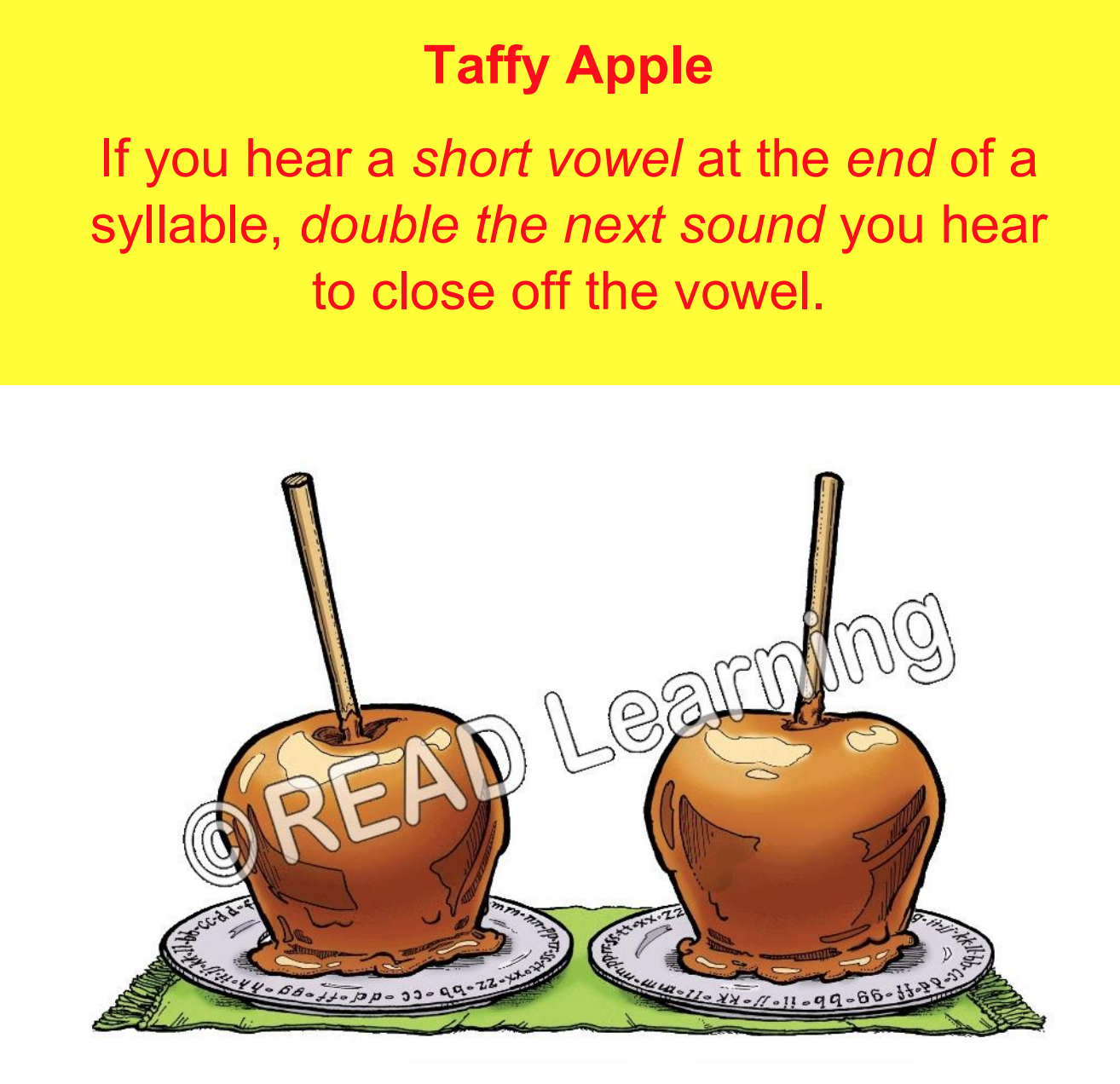
Now, it’s easy to forget that this spelling rule is really just that: a spelling rule, rather than a reading rule. Therefore, it’s important to eventually practice this rule without visual assistance, relying on syllable division and vowel sounds. I might give my student an auditory drill with a mix of examples and nonexamples. It might go something like this:
“I say ‘Taffy.’ Now, you say ‘Taffy.”
“Taffy”
“Tap out ‘Taffy’ into its syllables.”
“Ta—fy"
“Will this word need the doubling rule?”
“Yes, because there is a short ‘a’ at the end of the syllable.”
“Great! Now, try writing it down to double check.”
Important Tips to Consider
Time for Dessert!
Just like our beloved sweet treats, we saved the best for last! I have some FREE reproducibles that I’d like to share as you navigate this new spelling rule. Unlike those impossible carnival games, you don’t have to do anything to win this prize. Simply click and print!
Taffy Apple Reproducibles Here
As always, if you found this blog helpful, please share it with your fellow teachers, parents, and interventionists. Interested in learning more? You can find our other spelling topics HERE, and don’t forget to check out our complete guide to spelling at www.Silvermoonspellingrules.com . If you need help understanding syllable division rules see our video section (vlogs) HERE.
Happy Teaching!
Written by:
Kate Wagner, BSE
Reading Interventionist, Remote Learning Coach
Psst...PSST! I have a secret to share with you...I know the secret to spelling a really tricky sound. It’s one of those sounds that even good spellers sometimes mix up. Do you know the best part? I give you permission to share this secret with ANYONE!
If you’ve been following along, I’ve been sharing tips and tricks related to spelling the /k/with its kooky, sometimes pesky, series of spelling patterns. This is the secret to spelling /k/ in the middle of a word.
Before You Begin
● Teach spelling /k/ at the beginning of a word (find out more here)
● Teach spelling /k/ at the end of a word (find out more here)
● Distinguish the differences between long vowels, short vowels, and consonants
● Distinguish between one-syllable and multi-syllable words
● Demonstrate ability to divide multi-syllable words
 Photo by Annie Spratt on Unsplash
Photo by Annie Spratt on Unsplash
Now For the Secret
Before I spill the metaphorical beans, I am going to stress that this rule is only needed for multisyllable words, where there is a need to spell /k/ in the middle of a word. However, if you can recall our other /k/ rules, you’ll be in good shape for this one.
To begin, there are three choices for spelling /k/ in the middle:
C, CK, and K
As with our rule Cubs Can Drink Cola, always try the letter “C” first. If that letter works, stop there. If there is a ssssneaky vowel after the /k/ sound (e, i, or y), then try using “CK.” “CK” will only work if there is a short vowel right before that sound. Does that sound familiar? If so, you may be thinking of the Sick Elk rule. What happens if “C” didn’t work and “CK” didn’t work? Well, your last choice will always be “K.”
Whew! Sounds complicated! How can we simplify this a bit? If you’ve gotten to know us well enough here at Silver Moon Spelling, you know that we always have a catchy slogan to swoop in and jog your memory. This spelling rule is no exception.
The Secret Cricket Has Spoken
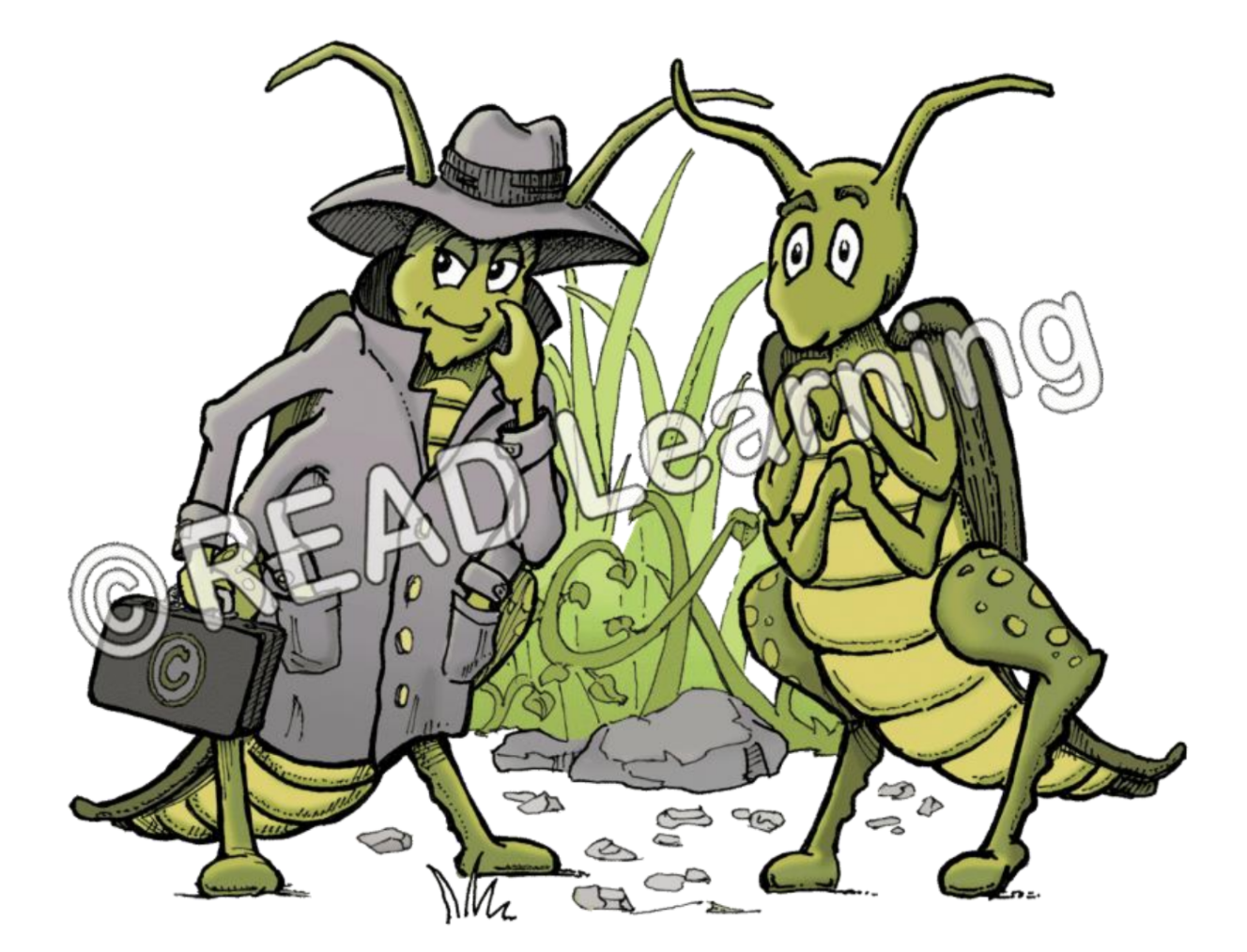
1. Spell /K/ with a C if there’s an a, o, u, or consonant after it.
If this doesn’t work...
2. Spell /K/ with a CK if there’s a short vowel in front of it.
If neither of these work...
3. Spell /K/ with a K.
Now, because this is a more complicated rule, it works well when I point out to students that they can use their student spelling rule cards to help them remember the order in which they must try spelling that middle /k/ sound. The order can be found in both the name of the rule, The Secret Cricket Has Spoken, and in the picture itself. I encourage you to take a moment to harness your inner child and indulge in a little search-and-find for the “C,” “CK,” ad “K” in our cricket illustration!
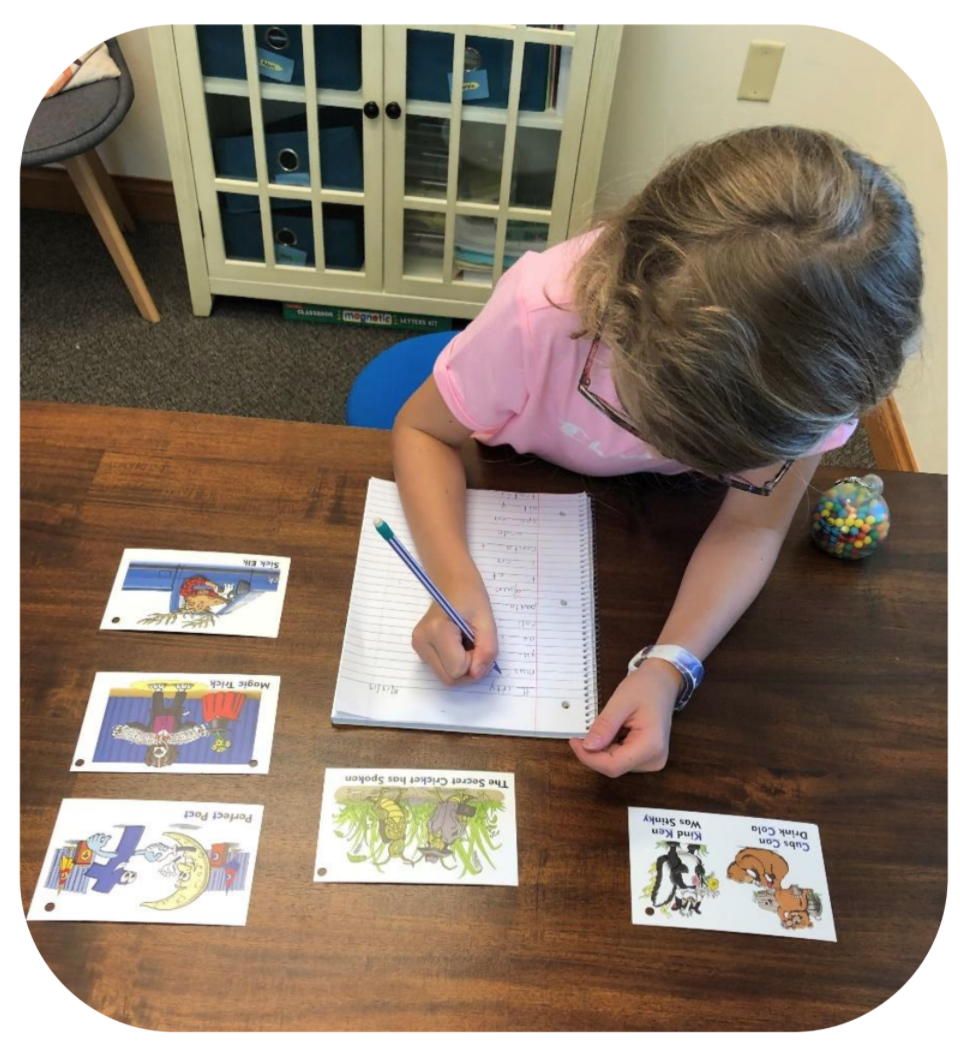 One of our students working hard to learn this new rule by using her Silver Moon Spelling rule cards.
One of our students working hard to learn this new rule by using her Silver Moon Spelling rule cards.
Important Tips to Consider
Psst...I Have FREE Resources
I’d like to share with you my secret stash of FREE resources that you can click, print, and use as you teach this rule with your students. Unlike the monotony of many reproducibles, ours tend to be interactive to facilitate active learning in our students.
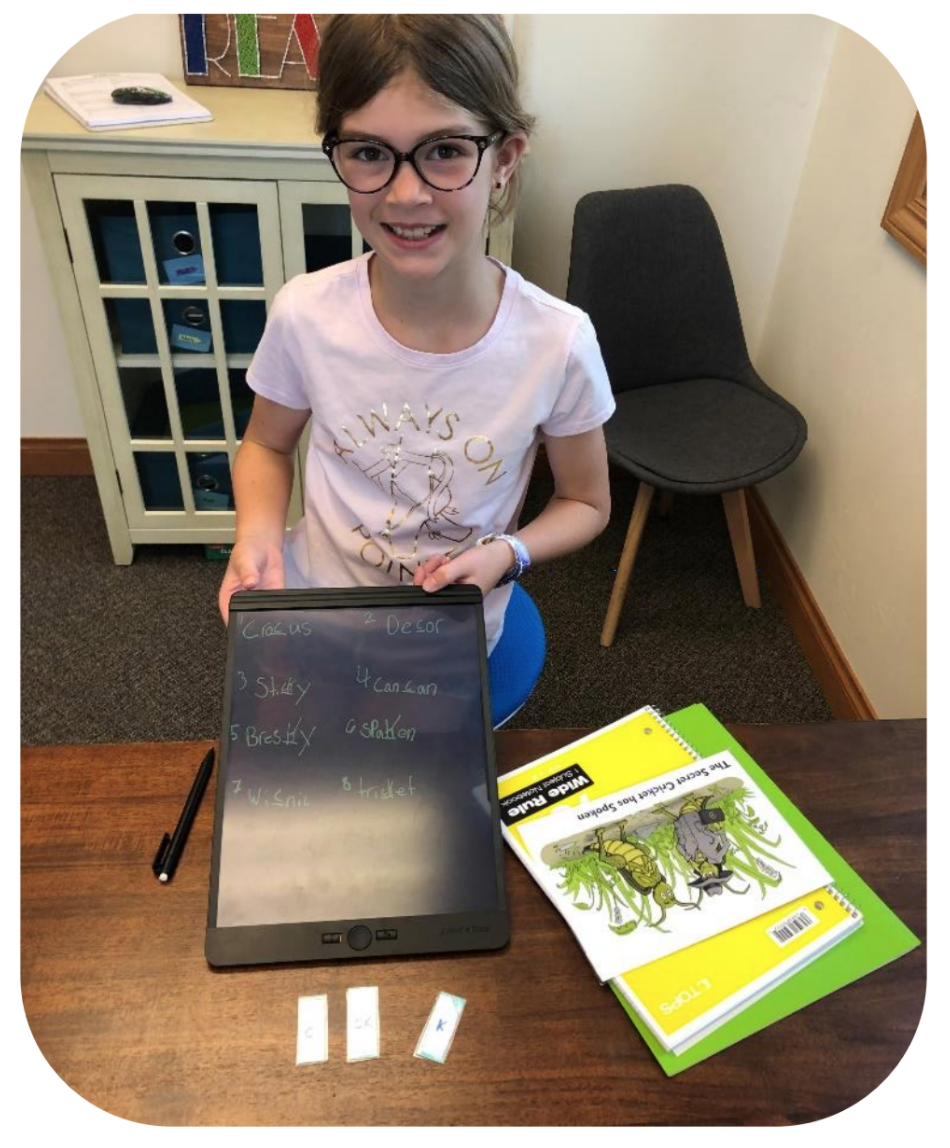 There's nothing better than finding success in a new spelling rule!
There's nothing better than finding success in a new spelling rule!
Here’s the next part of the secret: share our secrets with EVERYONE. How often are you given permission to share a secret? If you know of any teachers or parents who might benefit from our resources, please share them! Who doesn’t love free stuff?
Secret Cricket Reproducibles Here!
As always, if you found this blog helpful, please share it with your fellow teachers, parents, and interventionists. Interested in learning more? You can find our other spelling topics HERE, and don’t forget to check out our complete guide to spelling at www.Silvermoonspellingrules.com
Happy Teaching!
Written by:
Kate Wagner, BSE
Reading Interventionist, Remote Learning Coach
Imagine yourself as a struggling speller… You know your letter-sound correspondences. You’ve worked hard to learn the differences between long and short vowel sounds, and you’ve worked through these funky things called digraphs (th, sh, ch, ck, wh). Now you’d like to simply sit down and write, but as you get started, you quickly realize that there are some words that you just can’t seem to spell. These are words you’ve heard hundreds of times. You’ve even seen these words before, but of course, you can’t picture what they look like in this moment. You see, the trouble is that the sound /k/ can be spelled in several different ways! Is it ‘K’? Is it ‘CK’? You remember that ‘C’ is used quite a bit too. If only someone could tell you exactly when to use each spelling!
 Photo by Les Anderson on Unsplash
Photo by Les Anderson on Unsplash
Is your heart pumping just a little bit faster as you think about this scenario? Then perhaps this imagery is more familiar to you than it is to other adults that you know. Here’s the exciting part: There IS a formula you can show your struggling spellers that will tell them exactly when to use each spelling. Thank goodness!
Before You Begin
Before we dive into the details, let’s look at some prerequisite skills that your student will need before our new rules are taught. If you’ve read my other blogs before, some of these skills will look familiar. Before teaching, make sure your student knows:
The ‘Good Stuff’
At this point, your student knows the above skills, so it’s time to dig into the spelling rule. To properly explain how to spell /k/ at the end, let me introduce you to our guest, the Elk...

Now, Mr. Elk may not look like he’s into this gig, but I assure you, he’s just not feeling himself. In fact, he’s quite under the weather.
Sick Elk
“At the end of a word, always spell /k/ with a CK after a short vowel—otherwise use K.”
Well, I suppose Mr. Elk’s tough day has helped us discover our first rule when spelling /k/ at the end! Let’s hash that out for a moment. First, it’s important to emphasize that there are two common ways to spell /k/ at the end of a word: CK and K. In order to know which to use, the speller must look at the letter right before the /k/ sound. Then, insert a CK if it’s a short vowel and K if it’s not. Easy peasy, lemon squeezy!
Unlike Kind Ken was Stinky and Cubs Can Drink Cola, this rule is a bit easier to navigate, as your student only has to look at the letter right before the target sound, following natural left-to-right writing order. I still tell students to begin practice by leaving a blank spot at the end and referring to their student spelling rule cards before deciding how to spell /k/.
Alright, let’s allow Mr. Elk to get some rest. Before we check out those great practice activities that we’ve grown to enjoy, I have one more guest to introduce you to!
Magic Trick
I’m going to withhold our next rule for just a moment to give you a bit of background information. While Sick Elk works most of the time to spell /k/ at the end of a word, it’s important to remember that there is a special sound that we need to pay attention to. At the end of a multisyllable word, we have to break our normal Sick Elk spelling pattern when we hear the sound /ick/. That’s right; it’s like that sound you make when you smell old leftovers—“ick!!” Some might call this a ‘rule breaker,’ but instead, I like to just call it a ‘special sound.’
“At the end of a multi-syllable word, /ick/ is spelled IC.”
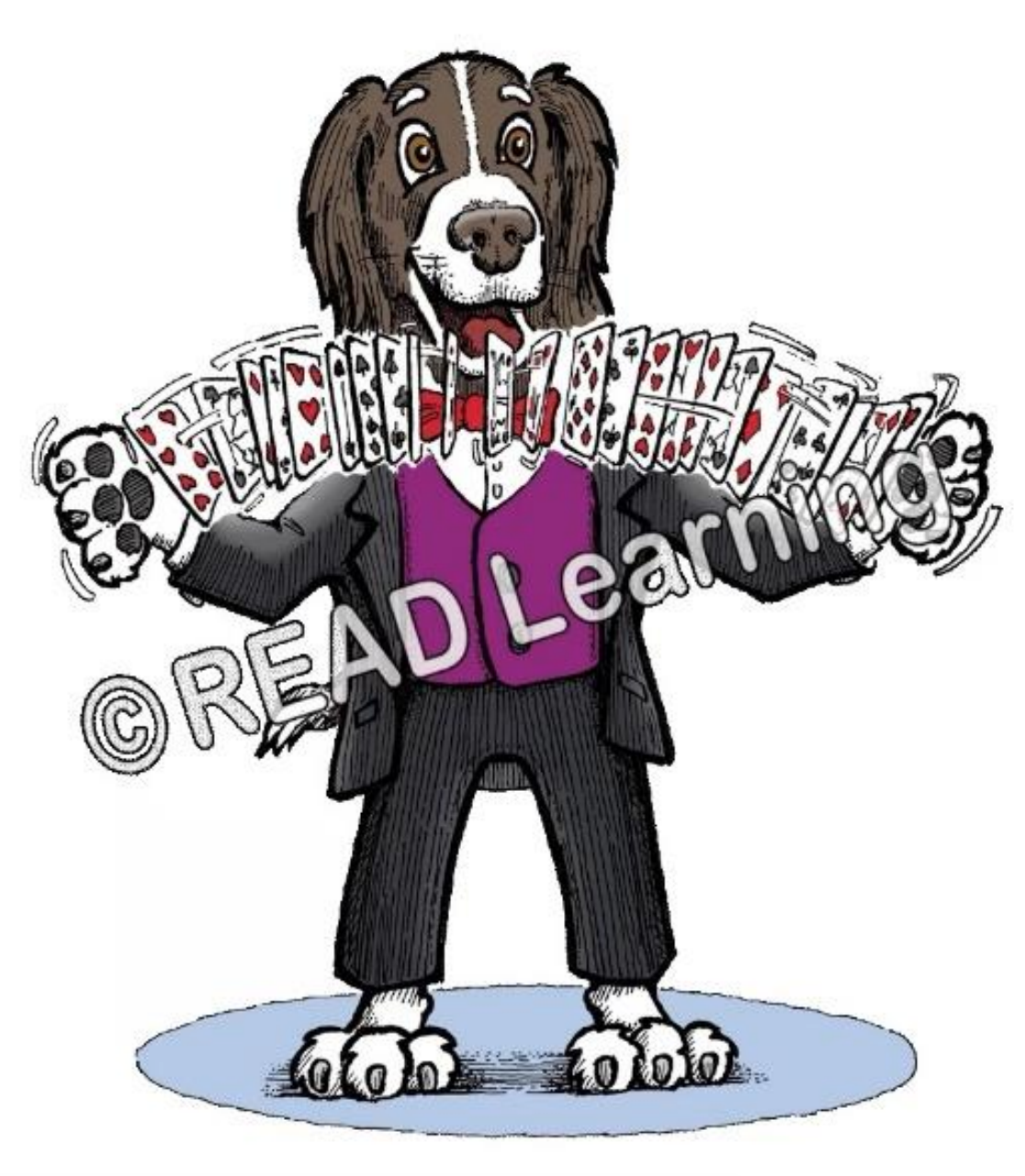
And now we can all let out that pent up, ‘aww,’ as we appreciate just how cute our magician dog friend is! 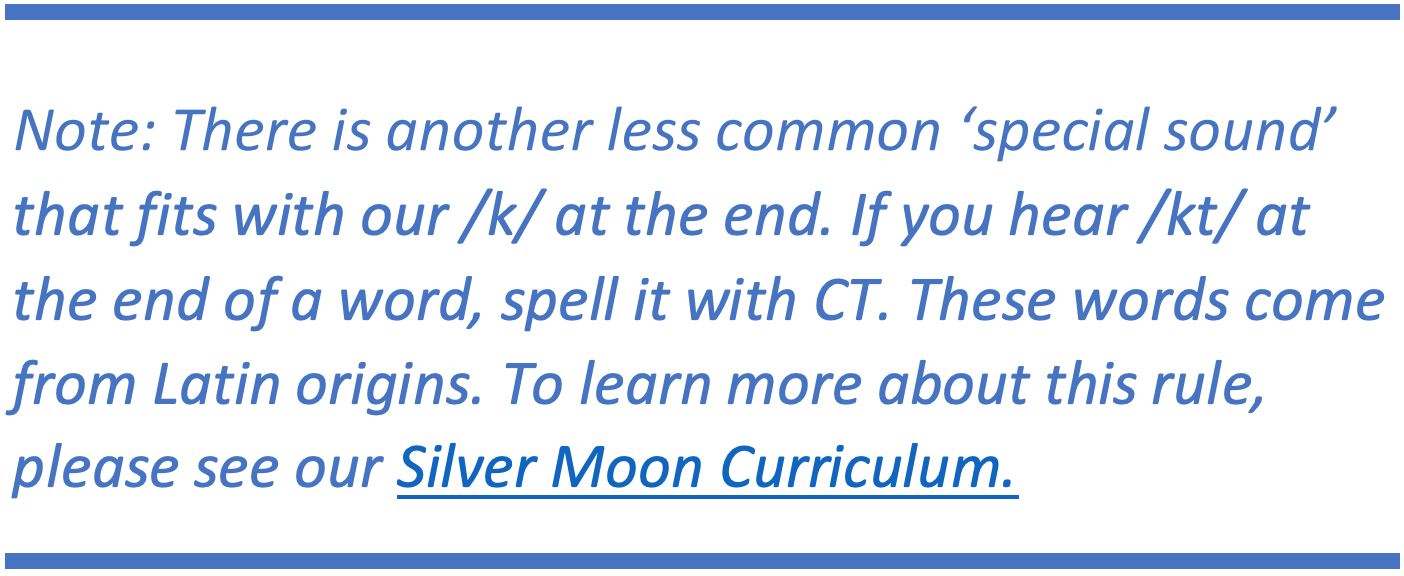
Important Tips To Consider...
More 'Good Stuff'
You may know what’s coming next, and if you do, thank you for following our Silver Moon blog. If you don’t, then let me be the first to welcome you! You are in for a treat. Below, you will find a collection of FREE practice activities and reproducibles for you to use as you teach this rule to your student. All you have to do is click, download, and print!
Sick Elk and Magic Trick Reproducibles
As always, if you found this blog helpful, please share it with your fellow teachers, parents, and interventionists. Interested in learning more? You can find our other spelling topics HERE, and don’t forget to check out our complete guide to spelling at www.Silvermoonspellingrules.com
Happy Teaching!
Written by:
Kate Wagner, BSE
Reading Interventionist, Remote Learning Coach
Let’s chat about the challenge of matching the correct spelling for /ch/ when you have a bunch of ways to spell it. It really is a cinch if you ditch the guessing and snatch the rule from this catch-y blog entry!
Okay, okay, enough of that chatter. Yes, I suppose I am a much better teacher than I am a poet, but the sentiment remains the same. Many of our students struggle with the correct spelling for the sound /ch/.
Why is that?
Let me divert for a moment to an analogous story...
As a child growing up in small-town Wisconsin, I discovered that if I wanted to be one of the “cool kids,” I had to learn how to bowl. So, I took to the lanes trying every method imaginable.
 1. Photo by Michelle McEwen on Unsplash
1. Photo by Michelle McEwen on Unsplash
In an attempt to keep my ball out of the gutter, I tried bowling right-handed, left-handed, and sometimes even two-handed! Should I walk or run up to the lane? Well, needless to say, this wasn’t a very efficient way to get better at bowling. I finally asked a friend to teach me how to bowl. It turns out, there are strategies for every possible bowling situation! As an awkward preteen, I would have never guessed these strategies on my own.
This is not unlike our students who struggle with spelling, grasping at any possible spelling combination until they settle on one that might look right. On the other hand, explicit instruction of spelling rules removes the guesswork from spelling, allowing our students more mental space for all of that fantastic writing content!
Now, back to the topic of spelling /ch/…
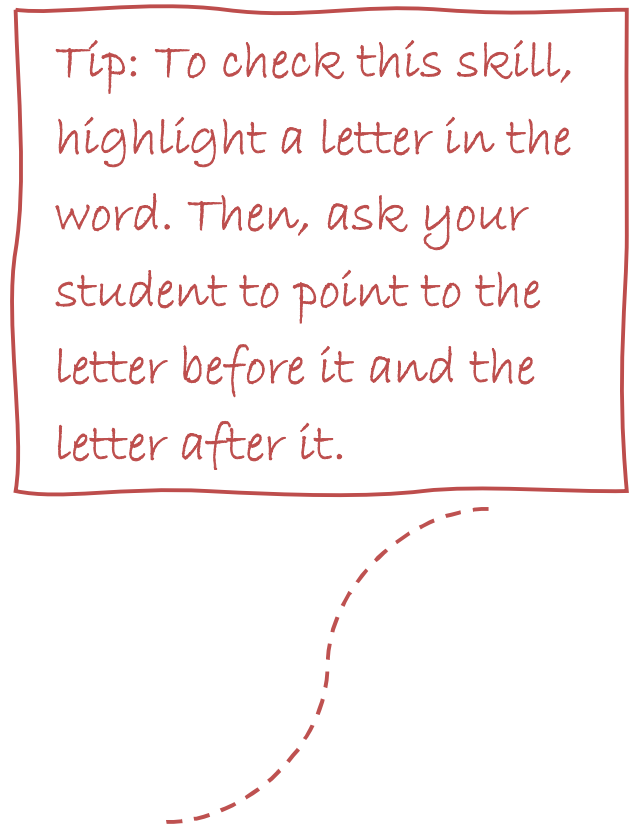 Let’s talk about prerequisite knowledge first.
Let’s talk about prerequisite knowledge first.
Your student will need the following skills before you can begin teaching
this rule:
Now that we have our “ingredients” sorted out, let’s get to cooking! I know, the metaphors are getting a bit tiring, so let me add some clarity. Here’s our rule:
“Always use TCH after a short vowel—otherwise use CH.”
Here at Silver Moon, we can’t have a spelling rule without a catchy phrase to help us remember it, and this one is absolutely delicious!
Munch a Batch of Cookies

This rule brings back the multisensory experience of indulging in a fresh batch of fresh, gooey chocolate chip cookies. Here’s how that rule shakes out:
Munch reminds us that we use a CH after a consonant (or long vowel).
Batch reminds us that we use TCH after a short vowel.
Exceptions to the Rule:
There are a few words that break this rule! These words are:
*Such *Much *Rich *Which
If you’re a busy parent or teacher, you probably don’t find yourself with loads of time on your hands. That’s why I created the following FREE reproducibles. And the best part? All the work is done for you. Just print and teach!
Munch a Batch of Cookies Reproducibles
If you found this blog helpful, you can find our other spelling topics HERE, and don’t forget to check out our complete guide to spelling at www.Silvermoonspellingrules.com
 2. Photo by Food Photographer | Jennifer Pallian on Unsplash
2. Photo by Food Photographer | Jennifer Pallian on Unsplash
Written by:
Kate Wagner, BSE
Reading Interventionist, Remote Learning Coach
Have you observed your student struggling to spell the /k/ sound? If so, this might look familiar:
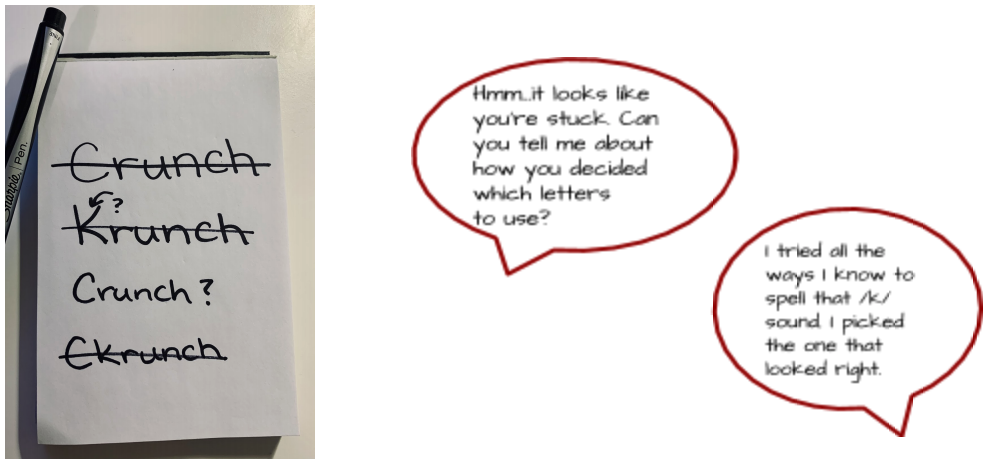
Of course, we want our students to use efficient and logical strategies while spelling, so we teach them spelling rules. I’m about to show you two handy rules that will clear up the /k/-Conundrum once and for all!
Before You Begin Teaching...
To begin, make sure your student has already mastered the following skills:
Once you’re sure that the prerequisite skills are met, you can begin to teach the spelling rule.
Spelling /K/ Explained with Two Simple Rules...
Begin by explaining that what you’re about to teach works when spelling /K/ at the beginning of a word. Spelling /K/ at the end is a bit different. I like to introduce this rule by first reminding my students to think about spelling in these simple terms:
“Say the sound you want to spell. Then, think about all of the ways you can spell that
sound.”
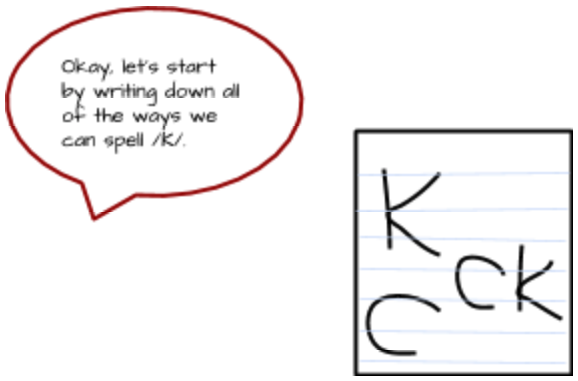
Yes, it’s that easy!
Next, explain the digraph “CK” cannot be used to begin a word. This is the point where most students breathe a sigh of relief. Now there are only two choices!
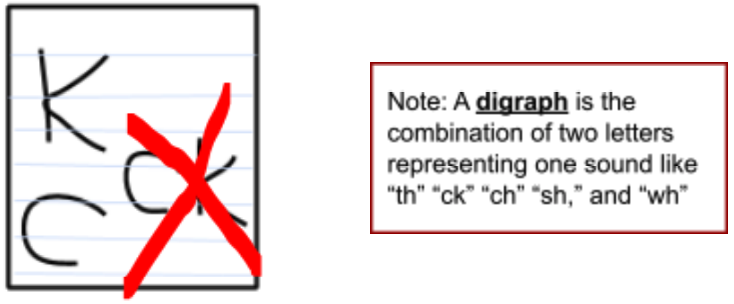
Okay, But What about the Rules?
Ahh..you’ve come here for the rules! That’s right. Because this concept relates to multiple scenarios we’ve split them into two categories named by the following two rules:
Cubs Can Drink Cola

The most common way to spell /K/ is with the letter “C,” so we should always consider spelling with the letter “C” first.
However, sometimes, the letter “C” can be tricky. When it comes right BEFORE a Sssssneaky Vowel, it will make the /S/ sound (like in the word “cent”). Sssssneaky vowels include e, i, and y.
“Spell /K/ with a C if there’s an a, o, u, or consonant after it.”
Kind Ken Was Stinky

And what to do if there is a Sssssneaky Vowel? Easy! Just choose the other option, “K.”
“Spell /K/ with a K if there’s an e, i, or y after it.”
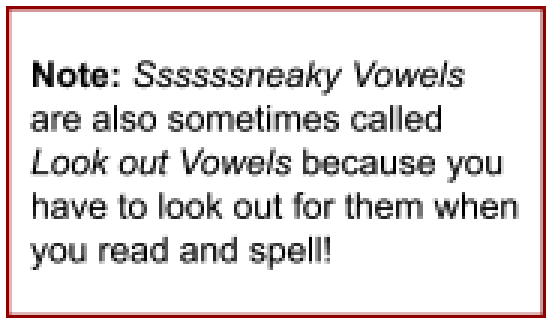
How cute are Ken and those Cubs?! As much as I’d like to say they were created just to melt our hearts, they serve an important role in rule memorization. In fact, when students can connect a new concept to a story, visual, and mnemonic device, they are much more likely to apply and remember this new knowledge!
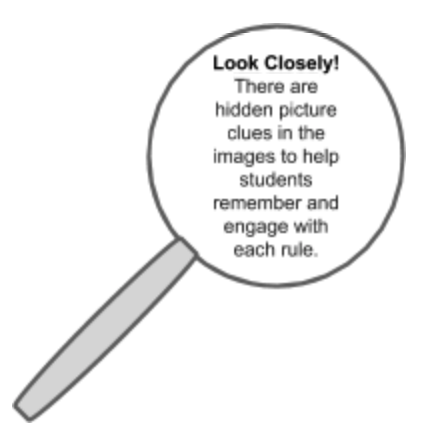
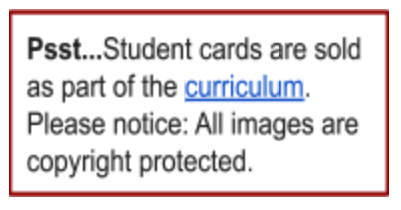
Important Tips To Consider...
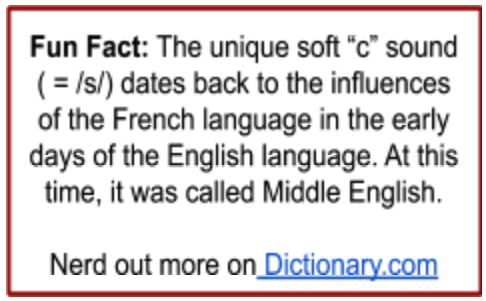
Remember: We teach spelling rules to students so that they don’t have to use inefficient strategies like guessing. However, don’t become discouraged if your student still reverts to guessing strategies. This compensatory skill is most likely still a knee-jerk reaction to spelling unfamiliar words! When this happens, keep bringing your student back to the rules they’ve learned.
Free Reproducibles!
Practice these skills with our FREE resources.
Download to Print: Spelling _k_ Worksheets and Answer Keys Combined (1)
If you’ve found this article useful for solving your /K/-Conundrums, please share this post! Don’t forget to check back for more spelling and reading discussion, tips, and resources.
Check out the rest of our spelling rules at www.Silvermoonspellingrules.com
Happy Teaching!
Written by:
Kate Wagner, BSE
Reading Interventionist, Remote Learning Coach
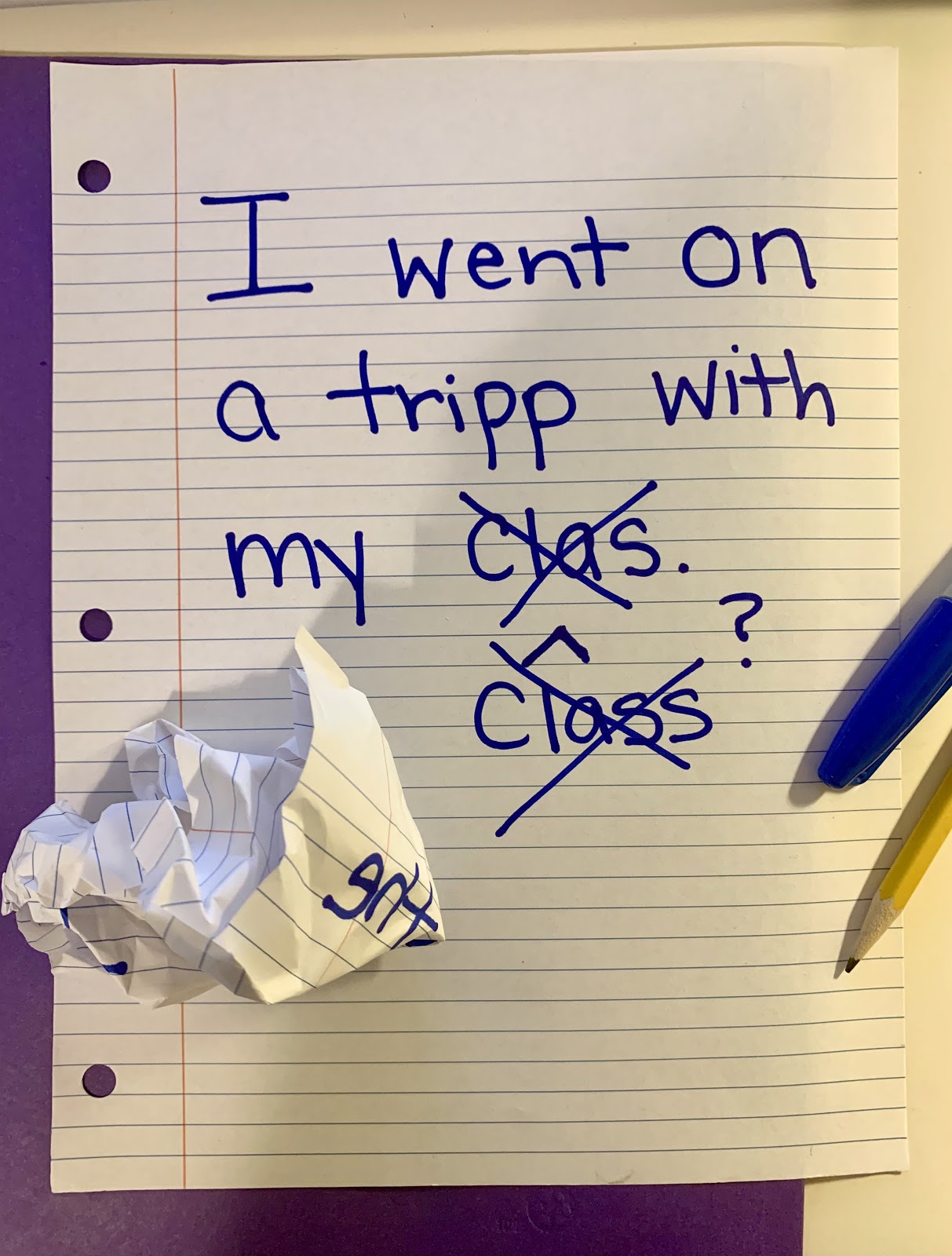
As educators and parents of struggling spellers, we all can relate to the writing sample above. Students are often confused about how to double letters when they come at the end of a word. As seen in the word “tripp,” struggling spellers will often over-generalize doubling rules in an attempt to make sense of the spelling patterns that they’ve noticed on their own. This is neither unique nor irreparable; all you need are the tools to teach the rules!
A Quick Note About Generalization…
Generalization is the skill used to apply one concept to many different situations. Generalization is often used in a positive way, and in education, we celebrate those moments our students generalize skills that we’ve explicitly taught as it often demonstrates mastery. In the spelling world, note that the words ‘generalization’ and ‘rule’ may be used to mean the same thing. Kelly Steinke, author of Silver Moon Spelling Rules, describes the reasoning for this in her up and coming book, Silver Moon Spelling Rules, Set 3.
“The term ‘spelling rule’ will be used interchangeably with the term ‘spelling generalization’. This is because, at this point, students need to use critical thinking skills to consider possible spelling choices when there may be more than one way to spell a given sound. Spelling rules are a construct, or way to think about and organize spelling choices.”
Silver Moon Spelling Rules, Set 3 © 2021
And yet, there is such a thing as over-generalization. This is that all-too-familiar phenomenon where a student takes a self-appointed spelling pattern and applies it to the wrong situations (as seen above in the writing sample). Think of this like that moment that you learned dessert comes after dinner. As soon as you generalized this “rule,” you might have begun to expect dessert after EVERY meal. I’m sure you learned quickly that this simply wasn’t a rule that you could generalize to each meal, or perhaps you’re like me and still learning.
Back to Doubling…
Okay, so your student has some confusion over doubling. What now? It sure would be nice to simply tell your student the rule (often called the FLOSS rule) and fix the issue right there! However, we know we need a bit more than that to reach our students. Well, don’t panic because I’d like to share an engaging, multisensory set of strategies and FREE resources to alleviate the stress of tackling the doubling hurdle.
Before You Begin…
To begin, make sure your student has already mastered the following skills:
(mat= 1 vowel and 1 syllable, picnic= 2 vowels and 2 syllables)
*Note the exceptions: vowel teams and some silent ‘e’ syllables
Once you’re sure that the prerequisite skills are met, you can begin to teach the spelling rule.
Sam Loves Fried Zucchini…
Did I catch your interest? Good. That’s the goal. This fun phrase was created to help students remember the doubling rule. You may be familiar with the traditional mnemonic FLOSS. And while this is a handy mnemonic that has been used for many years, it’s not very engaging. That’s how Sam and his fried zucchini were born.

If you’re not familiar with this doubling rule, let me tell you how it goes:
“At the end of a word that has one vowel, double the letters F, L, S, and Z.”
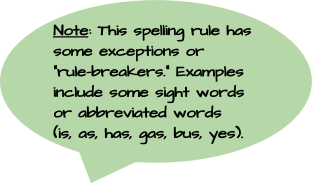 There are two components to this rule:
There are two components to this rule:
So, with that knowledge, let’s revisit our catchy phrase again:
Sam Loves Fried Zucchini
Notice that the first letter to each word represents one of the four letters that will be doubled using this rule. Pretty nifty!
Important Tips To Consider...
The easiest way to practice this skill is to give your student a list of words. Have your student find and circle all words with 1 syllable on the page by counting the vowels. Then, have your student read each 1 syllable word out loud.
Rather, provide the student with a resource that already has the rule written down for them. I highly suggest the Silver Moon Spelling Rules cards complete with illustrations of Sam and his fried zucchini. Both student and instructor sets of cards can be found at this handy link.
You may find that students have learned to memorize a lot of words. This is especially common when working with older students. Therefore, it’s difficult to know for sure if your student has really learned the spelling rule to the point of generalization (note that this is the ‘good kind’ of generalization). Using a mix of real words and nonsense words helps you better understand what your student knows and eliminates the memorization variable.
It may seem obvious to us, but it’s not always obvious to emerging readers and spellers.
And On to the Free Resources...
Okay, okay...if there’s one thing I’ve learned as a teacher, FREE resources rock! Download, print, and enjoy these free reproducibles to practice our new rule.
Sam Loves Fried Zucchini Reproducibles
As you can see, this is a really fun way to teach doubling that you can use with your students! I hope you give it a try and, if you love it, share this article with someone else.
Check out the rest of our spelling rules at www.Silvermoonspellingrules.com
If you want to see how the free reproducible work, check out this vlog where Kelly and Kate discuss the blog and the sheets!
Written by:
Kate Wagner, BSE
Reading Interventionist, Remote Learning Coach
Struggling with spelling can be embarrassing as a child and even more embarrassing as we grow older. Some people might think that because there is spell check on our phones and our computers and because we rarely physically write notes to employees, that spelling is not as necessary as it used to be. But have you ever wasted time guessing how to spell a word right and spell check keeps underlining it in red because it is incorrect, or your phone keeps auto correcting the wrong word? Word prediction software is not always reliable, and can cause embarrassing mistakes. Some people might struggle with this more than others and part of this struggle comes from not learning the basics when we learn spelling in grade school. To start to tackle spelling issues, you need to first acknowledge some common spelling mistakes. 
 Base words ending in ce and ge will not drop silent e unless the suffix begins with an e, i or y. This is because e, i, and y make the c and g say a soft sound. For example: nice and nicely, huge and hugely.
Base words ending in ce and ge will not drop silent e unless the suffix begins with an e, i or y. This is because e, i, and y make the c and g say a soft sound. For example: nice and nicely, huge and hugely.2. One Word or Two Words: Combining two words to make one new word creates a compound word. This gets confusing for spellers because words like everyday versus every day are both acceptable spellings in the English language but are used differently. Other examples that can be confusing are seashell vs sea shell, hot dog vs hotdog, gameday vs game day, etc. Oftentimes only one form of the word is correct, and it can be hard to know which one to choose.
3. Problems with Homophones: Homophones are words that sound the same but have different meanings or uses. The most commonly misused homophone would be their, they’re, and there. Some other examples are witch and which or weather and whether. Homophones present a big stumbling block when it comes to spell check. These words are commonly misused because though they may be spelled correctly it doesn’t mean they are used correctly. One tip to help with usage is an app called, Grammarly. This is an amazingly helpful tool!
4. Irregular Words: Let’s face it, there are words in our language that just don’t seem to follow any sort of normal pattern or rule. When it comes to irregular words we need to rely on memorization as opposed to understanding and applying a spelling rule or deriving the logic of spelling from the origin of the word. You’ll have better luck remembering how to spell irregular words if you can attach some logic to the illogical spelling patterns and use simultaneously multisensory strategies
(visual/auditory/kinesthetic). Some examples of irregular words are: Tuesday, Wednesday, often, does, goes, and through. Using sensory sand is one example of a simultaneously multisensory technique. As a student traces the word in the sand they are able to see the letters in the sand while at the same time feeling the formation of the letters, and at the same time hearing the letters as they say them aloud while spelling.
These four areas commonly cause trouble, when spelling, for children and adults alike. Spelling mistakes are even more difficult to overcome especially if the speller has dyslexia or dysgraphia. Silver Moon Spelling Rules is an Orton-Gillingham based spelling program. Orton-Gillingham is a method that allows students to get the level of individualized, explicit, and structured learning they need to succeed. Our experts at READ Learning continue to grow the Silver Moon Spelling Rules product line to help students, teachers, and parents succeed together. Check out our full product line here.
Teachers and parents often struggle to find the right tools to help students with spelling and/or reading difficulties. Dyslexia and dysgraphia are the most common reasons a person will struggle to spell. To help students with either learning disability, Silver Moon uses an Orton-Gillingham approach, an explicit, structured, cumulative, and multisensory technique, that builds a deep understanding of reading and spelling for our students.


Here are five benefits of Silver Moon, an Orton-Gillingham influenced program:
Dyslexia and other underlying learning difficulties can be hard to teach and, for students, hard to overcome. Orton-Gillingham is a method that allows students to get the level of individualized, explicit, and structured learning they need to succeed. Our experts at READ Learning continue to grow the Silver Moon Spelling Rules product line to help students, teachers, and parents succeed together. Check out our full product line here.